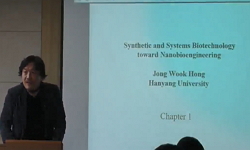Background and Objectives : Microbial invasion of the amniotic cavity is a significant clinical problem in obstetrics leading to infectious morbidity of both the mother and the newborn. So rapid and reliable test to detect bacteria in amniotic fluid i...
http://chineseinput.net/에서 pinyin(병음)방식으로 중국어를 변환할 수 있습니다.
변환된 중국어를 복사하여 사용하시면 됩니다.
- 中文 을 입력하시려면 zhongwen을 입력하시고 space를누르시면됩니다.
- 北京 을 입력하시려면 beijing을 입력하시고 space를 누르시면 됩니다.
165 rDNA PCR을 이용한 양수내 세균 검출 = Detection of Bacteria in Amniotic Fluid using 16S rDNA Polymeranse Chain Reaction
한글로보기https://www.riss.kr/link?id=A75164809
- 저자
- 발행기관
- 학술지명
- 권호사항
-
발행연도
2004
-
작성언어
Korean
- 주제어
-
KDC
510
-
자료형태
학술저널
-
수록면
187-192(6쪽)
- 제공처
- 소장기관
-
0
상세조회 -
0
다운로드
부가정보
다국어 초록 (Multilingual Abstract)
Background and Objectives : Microbial invasion of the amniotic cavity is a significant clinical problem in obstetrics leading to infectious morbidity of both the mother and the newborn. So rapid and reliable test to detect bacteria in amniotic fluid is urgently needed. The purpose of this investigation was to determine the feasibility of using the 16S rDNA PCR to detect bacteria in amniotic fluid.
Material and Method : Amniotic fluid samples from 15 pregnant women with hydramnios, preterm labor, or old age pregnancy were analysed with universal bacterial PCR. We used universal primers which amplify a DNA fragment of 16s rDNA from all known bacteria and sequenced the positive samples to identify the bacterial species, In some cases, routine bacterial culture, WBC, and CRP were studied also.
Result : Three of 15 pregnant women were positive in the PCR. DNA sequencing of the PCR product detected Staphylococcus epidermidis in one case, and Streptococcus anginosus in two cases.
Conclusion : The broad-spectrum bacterial 16S rDNA PCR assay, in properly controlled conditions, may provide a fast and reliable means for the detection of bacteria in amniotic fluid.
국문 초록 (Abstract)
배경 및 목적 : 양수강의 미생물 침습은 산모와 신생아 양자에게 감염성 질환을 야기할 수 있어 산과학에 있어 중요한 임상적 문제이다. 따라서 양수에서 세균을 검출할 수 있는 신속하고 믿...
배경 및 목적 : 양수강의 미생물 침습은 산모와 신생아 양자에게 감염성 질환을 야기할 수 있어 산과학에 있어 중요한 임상적 문제이다. 따라서 양수에서 세균을 검출할 수 있는 신속하고 믿을 만한 검사가 절실히 필요하다. 이 연구의 목적은 16S rDNA PCR을 이용하여 양수에서 세균을 검출할 수 있는지 그 실행가능성을 검사하는데 있다.
대상 및 방법 : 양수과다증이나 조기 분만, 노산 등이 있는 임산부 15인의 양수 검체를 16S rDNA PCR로 분석하였다. 모든 알려진 세균의 16S rDNA 분절을 중폭할 수 있는 보편적인 시동물질을 사용하여 증폭하였고, 양성 검체를 염기순서분석하여 세균 균종을 동정하였다. 일부 환자들에서는 세균 배양검사와 WBC, CRP 검사도 함께 시행하였다.
결과 : 15명중 3명의 임산부가 PCR에 양성이었고 PCR 산물을 DNA 염기순서분석한 결과 한 환자에서 Staphylococcus edidermidis가 다른 두 환자에서 Streptococcus anginosus가 검출되었다.
결론 : 광범위 세균 16S rDNA PCR 분석은 적절히 관리된 조건 하에서 양수내 세균 검출을 위한 신속하고 믿을 만한 방법을 제공해 줄 수도 있다고 생각되었다.
동일학술지(권/호) 다른 논문
-
- 朝鮮大學校 附設 醫學硏究所
- 하상호
- 2004
-
- 朝鮮大學校 附設 醫學硏究所
- 박찬국
- 2004
-
- 朝鮮大學校 附設 醫學硏究所
- 양은석
- 2004
-
- 朝鮮大學校 附設 醫學硏究所
- 김진호
- 2004




 RISS
RISS






